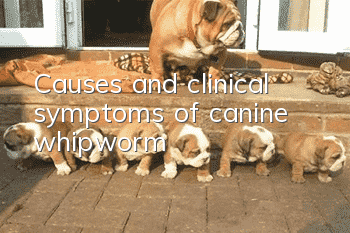Causes and clinical symptoms of canine whipworm

Causes of canine whipworm:
1. Trichocephala vulgaris is milky white. The front part is slender and filamentous, which is the esophagus, accounting for about 2/3 of the total length of the worm. The rear part is the body, short and thick. The body length of the insect is 45-75 mm, the rear part of the female insect is blunt and straight, and the tail end of the male insect is curled.
2. The eggs excreted in the feces will develop into infectious eggs in about 3 weeks under suitable conditions. After a dog ingests infective eggs, the larvae hatch in the intestine, burrow into the mucosa of the front of the small intestine, stay for 2 to 10 days, and then enter the cecum to develop into adult worms.
Clinical symptoms of canine whipworm:
1. Generally, infection does not show clinical symptoms.
2. In severe infection, acute or chronic enteritis can occur because the head of the parasite burrows deeply into the mucous membrane.
3. Blood-sucking worms often cause anemia in sick dogs.
- Why do dogs need their nails trimmed? Do you trim your dog’s nails?
- How long does it take for a dog to die from heat stroke? How many hours does it take for a dog to die from heat stroke?
- What are the reasons for dogs’ gastrointestinal problems? Dogs must be fed regularly
- How to treat urticaria in dogs Symptoms of urticaria in dogs
- How to train a dog to hold a ball Dog skill training methods
- Do you know what breeds the top three dogs with the highest IQ are?
- What to do if a dog eats shit? Is it true that a dog can’t change its habit of eating shit?
- Is Labrador aggressive? What are the advantages of Labrador?
- Symptoms of Diabetes in Dogs: Diabetes in dogs is related to your feeding sweets indiscriminately!
- Puppy weaning time Puppy care needs to be careful



